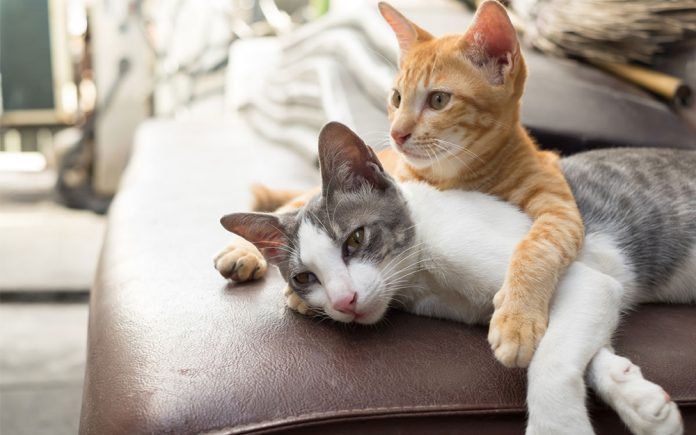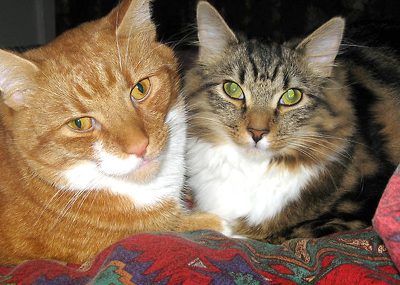
By Janet McAfee
Careful planning avoids the horrible hissing and fighting that can occur when some cats meet for the first time. Too many newly adopted cats are returned to shelters because their humans did not take the time to properly introduce them to their resident cat(s).
A great introduction method, explained in detail in the book, The New Natural Cat, by Anitra Frazier allows you to adopt a second cat without worry. What could be more fun than 2 cats engaged in joyful play, happily pouncing and chasing, twirling like circus acrobats?
INTRODUCING A NEW CAT TO THE HOUSEHOLD
Many owners think their “Fluffy” would be jealous or miserable if they adopted another cat. To the contrary, cats that live with another cat friend live longer, healthier and happier lives. If you have an elderly cat, a mature and calm companion works better than an active kitten. If you have an energetic cat, one that is equally playful or a kitten would be a good match. The steps below may take several hours to complete, but are well worth the investment when they ensure you can successfully adopt a second or third cat.
- Have someone outside the household arrive with the newcomer cat in a carrying case with plenty of air holes. Have torn strips of newspaper in the bottom of the case for later use.
- All family members must act completely oblivious to the new cat. The visitor sits in the living room with the cat inside the carrying case on his lap for about 20 minutes.
- Next the visitor moves the carrying case to the floor next to his feet. If your cat comes over and sniffs the case and walks away, ignore him, continue chatting and proceed to step 5. If your cat stays away from the case, include step 4.
- The visitor takes a few of the newspaper strips from the carrier, makes a trip to another room dropping a trail of the strips behind them. This gives your cat a chance to become familiar with the new cat’s scent.
- The visitor continues to sit and talk. When your cat sits calmly in the room without staring continually at the carrying case, you may proceed to the next step.
- Have all family members take your cat into the kitchen for a snack, closing the door behind. The visitor in the living room now opens the carrying case and lets the new cat out. Your cat won’t feel like its family put the newcomer in its territory, and this gives the new one some time to explore the new home.
- When your cat finishes his snack and returns to the living room, the family stays behind in the kitchen.
- When the cat returns to the living room, the visitor joins the family in the kitchen. Everyone acts oblivious to the cats who are now roaming free in the home.
- At no time should anyone offer expression of encouragement or interest in the cats. If you must check on things in the living room, have one person enter but without paying obvious attention to the cats. At this stage, hissing is perfectly normal; disgruntled muttering is less desirable but still to be ignored. If loud growling occurs, you may need to separate them, and this may mean one of the earlier steps was not carried out properly.
- When the cats cease pacing around and sit in the same room together, the humans leave the house for about a 30 minute walk.
- When you return home, greet your own cat while continuing to ignore the newcomer. If there is nothing worse than hissing going on, the visitor can leave at any time.
- The final stage of the introduction occurs at the cats’ own pace over the next few days or weeks. Hard as it might be, you must continue to ignore the new cat until your first cat has accepted him into the household. Chasing can be a good sign, especially if they reverse roles. Another sign of progress occurs when the cats sit in the same room without staring continuously at each other. Encourage activities for the 2 cats to do together, such as putting a couple of cardboard boxes together in a room for them to play on.
 The reward for all this work comes from the strong bond of communication and affection that develops between the two cats. Eventually that bond extends to their human companions. Watch the drama unfold, be proud of your success, and enjoy having two little furballs greet you when you arrive home! Now your cat will never be lonely when you’re away.
The reward for all this work comes from the strong bond of communication and affection that develops between the two cats. Eventually that bond extends to their human companions. Watch the drama unfold, be proud of your success, and enjoy having two little furballs greet you when you arrive home! Now your cat will never be lonely when you’re away.
Looking for second or third cat? Local shelters remain closed to walk-ins as we go to press, but you can still adopt a pet from them. The Riverside County Shelter, the Coachella Valley Animal Campus in Thousand Palms, www.rcdas.org, has many to select from, call (760) 343-3644 with the animal ID number. View more wonderful cats and kittens needing homes at www.kittylandrescue.org, and call (760) 251-2700 for an appointment to meet them. With the proper introduction, one of these wonderful cats or kittens will become a joyful addition to your household.
———————————————-
Below is a partial list of shelters and rescues in the Inland Empire with animals for adoption. You can view most of their animals online in advance of calling. If you cannot adopt, consider making a donation to one of the private rescues that rely on those funds.
COACHELLA VALLEY ANIMAL CAMPUS – This county shelter is closed but you can call for an appointment to adopt. You can view the animals at all 4 Riverside county shelters at www.rcdas.org, and get the ID number of the animal you want to meet. Email them with the animal’s ID number at shelterinfo@rivco.org and call (760) 343-3644. Located at 72050 Pet Land Place, Thousand Palms. (Public)
PALM SPRINGS ANIMAL SHELTER – The shelter is closed but you can call for an appointment to adopt. They schedule appointments Wednesday through Monday, closed on Tuesday. View their animals online at www.psanimalsshelter.org, 4575 E. Mesquite Ave, Palm Springs, (760) 416-5718. (Public)
ANIMAL SAMARITANS – The shelter is closed but you can call for an appointment to adopt. View their animals at www.animalsamaritans.org. Email acorrow@animalsamaritans.org to foster. Located at 72307 Ramon Rd, Thousand Palms, (760) 601-3918. (Private)
CALIFORNIA PAWS RESCUE – The shelter is closed but you can call for an appointment to adopt. Located at 73650 Dinah Shore, Palm Desert. View their animals at www.californiapawsrescue.com, (760) 656-8833. (Private)
HUMANE SOCIETY OF THE COACHELLA VALLEY – The shelter is closed but you can call for an appointment to adopt a dog or cat. View their animals at www.orphanpet.com. Located at 17825 N. Indian Canyon, Palm Springs, (760) 329-0203. (Private)
KITTYLAND – The shelter is closed so call for an appointment to adopt a cat. Located at 67600 18th Avenue, Desert Hot Springs, www.kittylandrescue.org, (760) 251-2700. (Private)
FOREVER MEOW – Foster based rescue for cats located in Rancho Mirage. Contact them through website www.ForeverMeow.org, or call (760) 335-6767. (Private)
LOVING ALL ANIMALS – The shelter is closed but you can call for an appointment to adopt. Located at 83496 Avenue 51, Coachella, www.lovingallanimals.org, (760) 834-7000. (Private)
MORONGO BASIN HUMANE SOCIETY – Located at 4646 Sun View Rd, Joshua Tree, www.mbhumanesociety.com, call between 11am-4pm for updates (760) 366-3786 (Private)
CITY OF SAN BERNARDINO ANIMAL SHELTER – Shelter is closed but you can call for an appointment to adopt. Hours for adoption 10am – 4pm Tuesday thru Sat. Google “City of San Bernardino Animal Shelter” for website to view animals and get the ID number of the animal you want to meet. Located at 333 Chandler Place, San Bernardino, (909) 384-1304 or (909) 384-7272. (Public)
SAN BERNARDINO COUNTY ANIMAL SHELTER AT DEVORE – Shelter closed but you can call for an appointment to adopt. Call (909) 386-9280 daily between 9am & 5pm. View animals at www.sbcounty.gov/acc and get the ID number of animal you want to meet. Located at 19777 Shelter Way, San Bernardino (Public).
DREAM TEAM ANGELS RESCUE – Foster based rescue located in Grand Terrace/San Bernardino area. Contact them through website www.DreamTeamangelsrescue.com, (360) 688-8884. (Private)











































